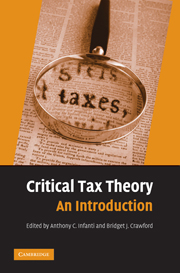Book contents
- Frontmatter
- Contents
- List of Illustrations
- List of Tables
- List of Contributors
- List of Common Abbreviations
- Introduction
- CHAPTER 1 FOUNDATIONS OF CRITICAL TAX THEORY
- CHAPTER 2 HISTORICAL PERSPECTIVES ON TAXATION
- CHAPTER 3 THE GOALS OF TAX POLICY
- CHAPTER 4 CRITICAL TAX THEORY MEETS PRACTICE
- CHAPTER 5 RACE AND TAXATION
- CHAPTER 6 GENDER AND TAXATION
- CHAPTER 7 SEXUAL ORIENTATION AND TAXATION
- CHAPTER 8 THE FAMILY AND TAXATION
- Love, Money, and the IRS: Family, Income-Sharing, and the Joint Income Tax Return
- Innocent Spouses: A Critique of the New Tax Laws Governing Joint and Several Tax Liability
- Taxation and the Family: A Fresh Look at Behavioral Gender Biases in the Code
- The Profits and Penalties of Kinship: Conflicting Meanings of Family in Estate Tax Law
- The Tax Treatment of Children: Separate but Unequal
- Rocking the Tax Code: A Case Study of Employment-Related Child-Care Expenditures
- CHAPTER 9 CLASS AND TAXATION
- CHAPTER 10 DISABILITY AND TAXATION
- CHAPTER 11 GLOBAL CRITICAL PERSPECTIVES ON TAXATION
- CHAPTER 12 CRITICAL PERSPECTIVES ON CRITICAL TAX THEORY
- Index
Love, Money, and the IRS: Family, Income-Sharing, and the Joint Income Tax Return
Published online by Cambridge University Press: 04 August 2010
- Frontmatter
- Contents
- List of Illustrations
- List of Tables
- List of Contributors
- List of Common Abbreviations
- Introduction
- CHAPTER 1 FOUNDATIONS OF CRITICAL TAX THEORY
- CHAPTER 2 HISTORICAL PERSPECTIVES ON TAXATION
- CHAPTER 3 THE GOALS OF TAX POLICY
- CHAPTER 4 CRITICAL TAX THEORY MEETS PRACTICE
- CHAPTER 5 RACE AND TAXATION
- CHAPTER 6 GENDER AND TAXATION
- CHAPTER 7 SEXUAL ORIENTATION AND TAXATION
- CHAPTER 8 THE FAMILY AND TAXATION
- Love, Money, and the IRS: Family, Income-Sharing, and the Joint Income Tax Return
- Innocent Spouses: A Critique of the New Tax Laws Governing Joint and Several Tax Liability
- Taxation and the Family: A Fresh Look at Behavioral Gender Biases in the Code
- The Profits and Penalties of Kinship: Conflicting Meanings of Family in Estate Tax Law
- The Tax Treatment of Children: Separate but Unequal
- Rocking the Tax Code: A Case Study of Employment-Related Child-Care Expenditures
- CHAPTER 9 CLASS AND TAXATION
- CHAPTER 10 DISABILITY AND TAXATION
- CHAPTER 11 GLOBAL CRITICAL PERSPECTIVES ON TAXATION
- CHAPTER 12 CRITICAL PERSPECTIVES ON CRITICAL TAX THEORY
- Index
Summary
The songs tell us that when two people are in love, their souls unite; their two hearts beat as one. The Code also tells us that their two tax liabilities can be as one, united in a joint tax return – but only if they are not simply in love, but are also married. While tax theorists have debated the appropriateness of the joint return, they have not examined the premise behind the joint return: that married people – and only married people – share not only their hopes and dreams, but also their money.
EMPIRICAL STUDIES OF ASSET POOLING AND CONTROL SHARING
The theoretical justification for the joint return – the belief that married couples share resources – is largely unsupported by empirical evidence. Recently, however, a number of studies have explored intrafamily allocations because of a growing recognition of this issue's importance to a wide array of social welfare programs. These studies indicate “that individual incomes are not simply pooled and then spent to meet household needs in some unified fashion. Rather, they are spent at least in part according to the earner's own preference.” This apportionment phenomenon is true even when the couple states that they pool or share resources.
I examined three studies of intrafamily resource allocation as well as my own. My study was an anonymous ninety-three question survey that was distributed twice. The three prior intrafamily studies I examined were the vast study in the 1983 book American Couples by Philip Blumstein and Pepper Schwartz, a small 1986 study of dual-career couples in the greater Chicago area by Rosanna Hertz, and an English study of 102 married couples conducted specifically on the issue of money and marriage by Jan Pahl.
- Type
- Chapter
- Information
- Critical Tax TheoryAn Introduction, pp. 224 - 230Publisher: Cambridge University PressPrint publication year: 2009
- 4
- Cited by



